Canon EF-S 18-135 mm f/3.5-5.6 IS
3. Build quality and image stabilization
The widest focal range is crucial when we get to the dimensions of the lens because the Canon is also the longest of all.
The photo below shows the tested lens positioned between the Canon EF-S 18-55 mm f/3.5-5.6 and the non-stabilized Sigma 17-70 mm.
Please Support UsIf you enjoy our reviews and articles, and you want us to continue our work please, support our website by donating through PayPal. The funds are going to be used for paying our editorial team, renting servers, and equipping our testing studio; only that way we will be able to continue providing you interesting content for free. |
- - - - - - - - - - - - - - - - - - - - - - - - - - - - - - - - - - - - - - - - - - - - - - - -
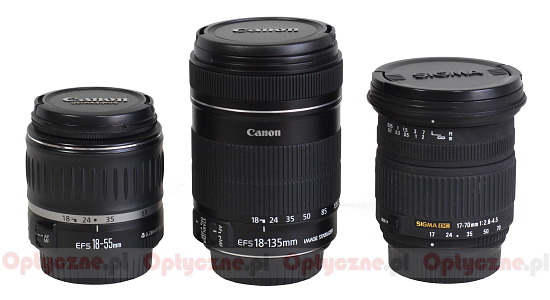 |
The first examination of the Canon EF-S 18-135 mm IS impressed us a lot. We expected a diminutive lens featuring plenty of cheap plastic parts as it comes from a low quality segment. When we took the lens into our hands we were very pleasantly surprised.
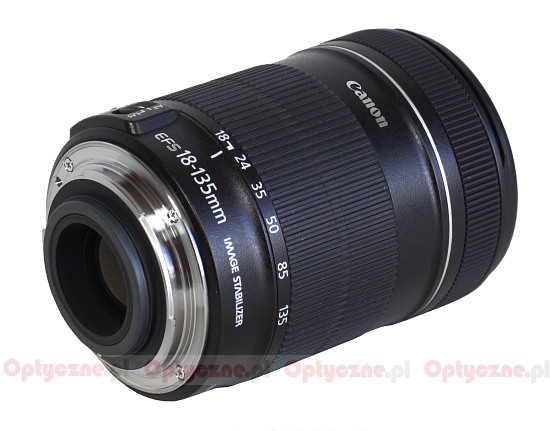 |
The lens starts with a metal mount inside which we find a rear element 2.5 cm in diameter. At 18 mm focal length it is positioned about 1 cm inside the barrel and on passing to 135 mm it retracts by additional several centimeters.
Immediately behind the mount there is a part of the barrel with the name of the lens and the information that it is stabilized. On the left we see a focusing mechanism mode switch (AF/MF) and the stabilization switch (STABILIZER ON/OFF).
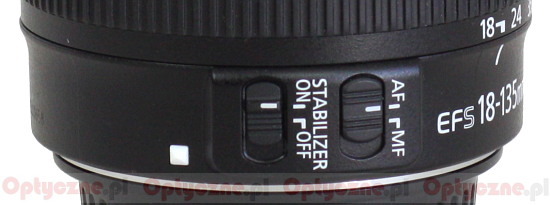 |
Then we have a zoom ring which, in fact, consumes a majority of the outer lens barrel. It consists of focus marks (showing values at 18,24, 35, 50, 85 and 135 mm), 34 mm wide ribbed rubber part and a smooth part of the barrel with the “Canon” inscription and a silver strip.
The zooming is smooth, with a constant amount of resistance required to adjust it. On passing to 135 mm the front element system extends on a uniform inner tube which looks relatively solid. When you use the maximum focal length the lens becomes 4 cm longer.
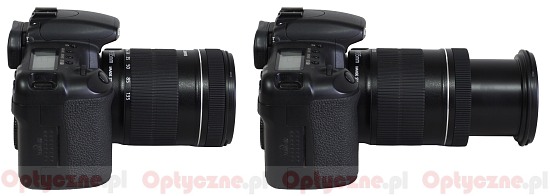 |
Further on, we see a focus ring. It is 12 mm wide, made of rubber and ribbed but unfortunately it lacks a scale of any type. The precision of work is perhaps not the best because running though the scale takes about 80 degrees but taking into account the significant depth of field, forced by the lens’s parameters, it is not a serious flaw.
The front element with a diameter of about 5 cm is surrounded by a part of the barrel featuring the name and the parameters of the lens and a non-rotating filter thread, 67 mm in diameter.
When it comes to the optical construction we deal here with 16 elements positioned in 12 groups. One element is aspherical and another one is made of low-dispersion UD glass. Inside the system we also find an aperture with six diaphragm blades which can be closed down in the range from f/22 to f/36, depending on the focal length used.
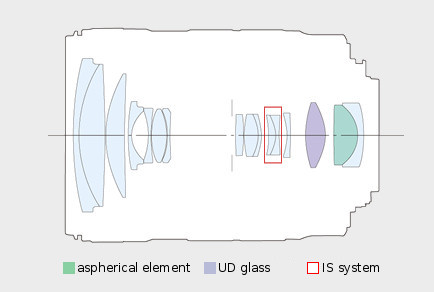
In this price segment Canon doesn’t supply any accessories apart from the caps. However, the competitors add a lens hood and a soft pouch in the same segment so Canon should be criticized here.
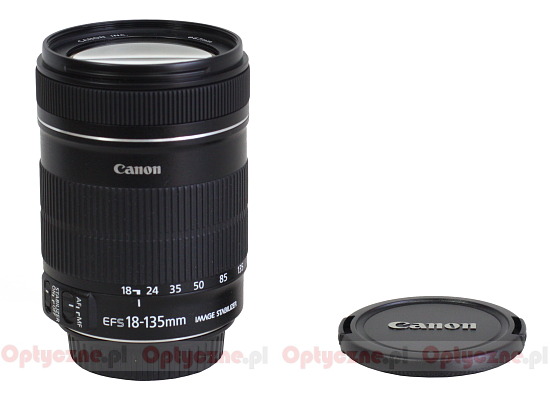 |
Stabilization
The producer boasts of using the stabilization system as efficient as 4 EV. We tested it in the standard way, taking several dozen photos at 135 mm for every exposure value, ranging from 1/200 to 1/4 of a second, with the stabilization on and off. Next we determined the percentage of fuzzy photos at every exposure value. That percentage as an exposure value function expressed in EV, was presented on the graph below. The zero EV point is the equivalent of 1/160 of a second.
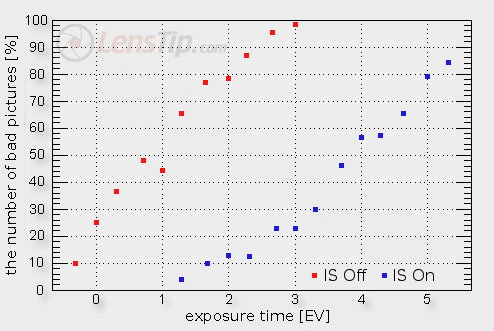
As you see you can forget about those declared 4 EV for sure. A solid 3 EV is still quite a good result for this class of equipment and it deserves to be praised.






